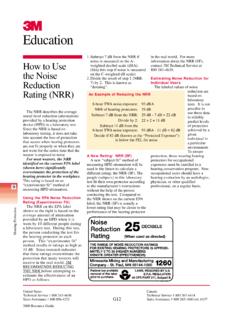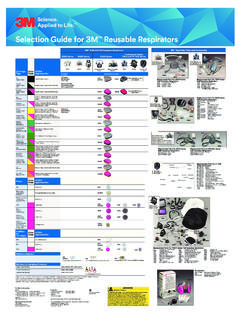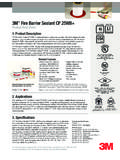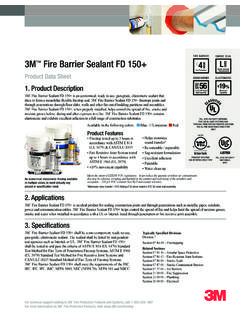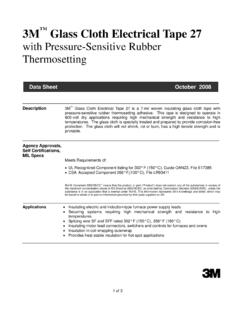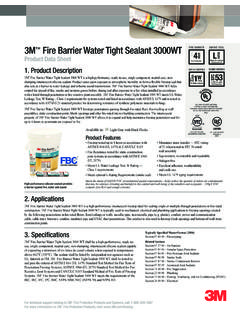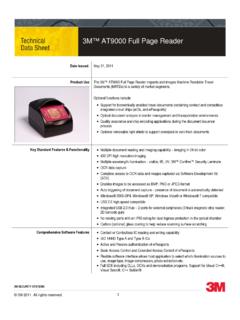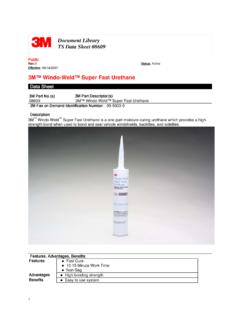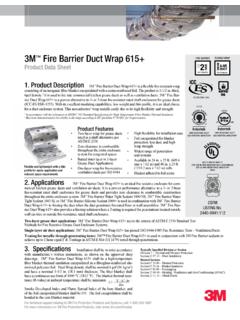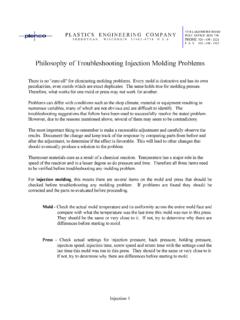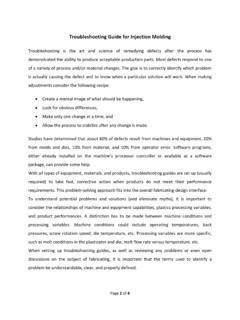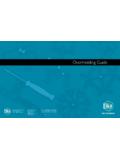Transcription of Injection MoldingGuide
1 3M Dyneon Fluoroplastic PFAI njection MoldingGuide2 Table of Contents1 Introduction 42 Product Properties 53 Equipment Specification Clamp Tonnage Injection Unit Barrel Materials of Construction Screw Design Nozzle and Nozzle Tip Screw Tip Assemblies Mold Materials and Design Materials of Construction Runners and Gates Fan Gating Sprue Gating Tunnel Gating Runner Systems for Multiple Cavities Hot Runner Systems Vents 124 Part Shrinkage 135 Annealing 146 Typical Processing Conditions Barrel Temperature Mold Temperature Injection Velocity Shot Size and Cushion Pack Pressure and Pack Time Back Pressure / Screw Recovery Speed 177 Additional molding Considerations Delamination Safety 198 Trouble Shooting 209 Appendix 2210 Notes 2323* Dyneon PFA 6502 is not generally recommended for Injection molding operations because of its high melt viscosity.
2 NZ, TZ: Standard applications. UHPZ: Ultra High PurityIntroduction3M Dyneon Fluoroplastic PFA is a high performance melt-processable thermoplastic made from tetraflu-oroethylene and perfluorovinylether. Dyneon PFA is characterized by exceptional heat and chemical re-sistance, superior weather resistance and excellent electrical s 6500 series of PFA is available in different melt flows to fit specific applications and processes. Dyneon PFA is also available as ultra high purity (UHP) material for semiconductor and other critical high purity of PFA materials include: Wide service temperature range from -200 C to +260 C (-328 F to 500 F) Exceptional chemical resistance Outstanding mechanical properties Very good non-stick properties Superior electrical properties Non-flammable / no flash point under normal conditions Exceptional resistance to environmental stresses such as weathering and Clamp TonnageThe clamp tonnage requirements for PFA are generally lower than for most polymers.
3 PFA has a high melt viscosity that leads to large pressure drops across the gate and runner system and Injection velocities must be reduced so that pressures can be kept low to prevent melt fracture as well as part fracture. Therefore, clamp tonnage requirements for PFA are generally low. The high viscosity of PFA does however reduce the occurrence of part flash-ing. For most applications, tons per cm2 (3 tons per in2) of projected part and runner area is Injection UnitInjection unit pressure requirements are low for PFA. High Injection veloci-ties and pressures are undesirable, because they cause melt fracture and part fracture. It is recommended to keep Injection pressures less than 1000 bars (15,000 psi) and pack pressures less than 700 bars (10,000 psi).Photo Copyright 2012. Elring 1 lists material properties of 3M Dyneon Fluoroplastic PFA that are useful in Injection molding Barrel SizingThe barrel should be sized to contain between to 4 times the shot capac-ity.
4 If the shot capacity is greater than 4 times the shot size, the increased residence time can cause thermal degradation of the Materials of ConstructionPFA is corrosive to common steel at usual melt processing temperatures. All parts of the machine that contact molten PFA and its vapors must be made using corrosion resistant metals. 4512 Product PropertiesPropertyUnitsTest MethodDyneon PFA 6502* NZ, TZ, UHPZD yneon PFA 6505 TZDyneon PFA 6515 TZ, NZ, UHPZD yneon PFA 6525 TZSpecific Gravityg/cm3 ASTM D792 / ISO Temperature C ( F)ASTM D4591 / ISO 12086310 ( 590 )310 ( 590 )310 ( 590 )310 ( 590 )Melt Index 372/5g /10minASTM D1238 / ISO 12086251525 Tensile Strength (at break)MPa (kpsi)ASTM D638 / ISO 1208630 ( )30 ( )26 ( )20 ( )Elongation%ASTM D638 / ISO 12086380410450350 Flexural ModulusMPa (kpsi) ASTM D790 / ISO 12086550 (80)550 (80)620 (90)630 (91)Table 1: Material Properties3 Equipment Screw DesignFigure 1 depicts the screw characteristics that are most important to consider in Injection molding operations.
5 Figure 1: Screw Diagram CharacteristicsDescriptionScrew Diameter RatioMultiply this number by the Screw DiameterLengthLength of flighted section of the screw20 Feed SectionLength of feed section10 to 12 Transition SectionLength of transition section4 to 5 Metering SectionLength of metering section4 to 5 PitchDistance between flights1 Flight WidthWidth of FeedFlight depth in the feed to MeteringFlight depth in the metering to Feed/FD to 3: Typical Screw Nozzle and Nozzle Tip The material path in the nozzle and nozzle tip should be smooth without pockets or rough transitions where polymer can stagnate and, over time, degrade. Figure 2 shows a cross section of a typical nozzle / end cap con-figuration. As shown in Figure 2, the screw tip and the end cap should be drafted with the same angle to prevent a dead spot between the two. The mate between the nozzle tip and the nozzle should be the same internal diameter to avoid a 3 shows the details of the nozzle tip.
6 The discharge end of the nozzle tip should be reverse tapered for the first 3 diameters (D1 *3) of the nozzle length with a 1 mm per 50 mm taper ( per foot taper). The discharge hole diameter should be - mm ( - ) smaller than the matching orifice in the sprue. The diameter of the nozzle side orifice (D2) should match the internal diameter of the nozzle. A common material of construction for the nozzle tip is Hastelloy 718 alloy since it is harder than most other corrosion resistant 3: Nozzle TipTable 2 shows an overview of commonly used screw and barrel materials for processing PFA. Ultra high purity applications in particular require the usage of alloys with low iron-content, such as Haynes 242 , Hastelloy C4 or Inconel materials are also broadly used in other applications throughout the industry. Internal barrel coatings made of Reiloy 115 and screws made from Inconel 625 or Hastelloy C4 are 2: Common Barrel and Screw Materials for Dyneon PFA Barrel MaterialScrew MaterialsXaloy 3091 Hastelloy C2762 IDM 2603 Inconel 6254 Wexco B0225 Haynes 242 alloy2 Reiloy 1156 Inconel 7254FD FeedFD MeterFeed SectionFlight WidthPitchTransition SectionMetering SectionScrew TipNozzle TipDie OrificeCombination Nozzle / End CapBarrelAAD2L1A - AD11 - 2 Figure 2: Combination Nozzle and End Cap67 Table 3 shows an overview of typical screw characteristics for processing Screw Tip AssembliesA commonly used screw tip assembly for fluoropolymers is the check ring.
7 Figure 4 shows a locking check ring and screw tip assembly. Corrosion resistant materials are relatively soft and the seats on the check ring and screw tip wear rapidly when the check ring is allowed to prevent this wear the check ring is usually locked. The screw tip should be as smooth as possible. Keep the flats on the screw tips small with only enough flat area to positively secure or remove the screw tip assembly and the 4: Locking Check Ring Materials of ConstructionAny part of the mold that contacts molten PFA must be corrosion protected. Since corrosive gases are liberated during processing, the vent system should also be protected. The mold cavity can be constructed from either a nickel alloy or plated tool steel. Nickel alloys are softer, more difficult to machine, and are poorer heat conductors than plated tool molds are often machined from tool steel and then plated using an electroless nickel plating process.
8 If a higher polish, lower friction, or longer wear is desired, nickel / PTFE coatings such as Polyond 7 or Nickelon 8 can be used. As the tool steel material in the core and cavity is protected from corrosion by the plating, the mold surfaces need to be replated before the finish wears through. Replating is also required following modifications or repairs. These are the main disadvantages associated with the use of plated plated molds are stripped and re-plated, it is important to use a stripping process that will not attack the base metal. Generally the faster the stripper the more chance there is of attack-ing the base metal. Thus, it is recommended to use a slower alkaline stripping process to avoid attack of the base Runners and GatesProper design of the gate and runner system is important for PFA. PFA is a high melt vis-cosity material and will melt fracture easily if sharp comers are present or if the runner or gate cross section is too small.
9 It is advisable to keep the runner and gate system large, smooth, streamlined, well radiused and as short as pos-sible. Should the runners or gates be too small, the part may not fill properly or it may need to be filled so slowly that it will have a poor surface Mold Materials and Fan GatingThe use of fan gates is recommended for many part configurations when Injection molding PFA. The use of fan gates result in the superior distri-bution of the molten material into the mold cavity therefore reducing the occurrence of delamination within the part, and minimizing the differential cavity pressure (maximum cavity pressure - minimum cavity pressure).A good illustration of a fan gate is given in Figure 5. The width of the gate at the part (W1) should typically range from 20 percent of the part width (W2) to 100 percent of the part width. The fan shouId be flared into the part with a 1 mm ( ) or greater fillet (R2). As part sizes are increased, the fillet (R2) should also be increased.
10 The wider the fan (W1) the easier the part will mold; however, narrower fans are easier to trim and use less material. Figure 5 summarizes the design guidelines for fan 5: Fan GatingFan Gating GuidelinesL1/2 W1W120 - 100% of W2T275 - 100% of T1D11 x - 3 x part thicknessR> 1 mm ( )T31 x - 2 x T1 (part thickness)Table 4: Fan Gating GuidelinesAAA - AAD1T2T1RT3A - AALW1W2 AAA - Sprue GatingSprue gating is commonly used in single cavity tools. Figure 6 shows a radially balanced part gated at the center using a sprue gate. It is gener-ally necessary to have the sprue diameter larger than the part thickness to reduce melt fracture and delamination. In the case of larger parts the sprue diameter can be as much as 4 times the part with all gating methods the sprue should be flared into the part with a generous radius. Sprue gate guidelines are summarized in Table Gate GuidelinesA12 3 R1> 1,5 x - 4 x T1 (part thickness)Figure 6: Sprue GatingTable 5: Sprue Gate GuidelinesFigure 7: Unbalanced Runner SystemFigure 8: Balanced Runner SystemFigure 7 shows an example of an unbalanced eight-cavity runner sys-tem.
